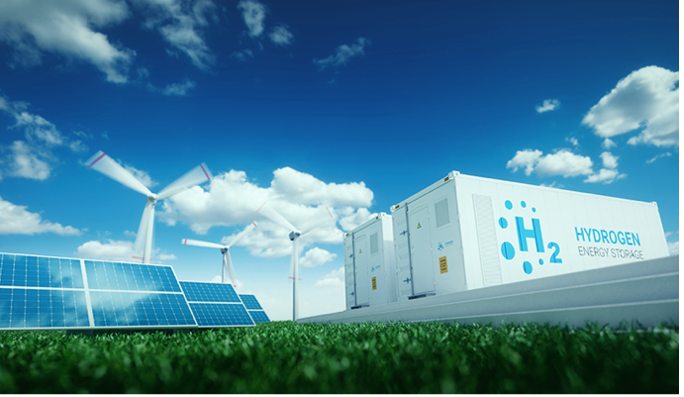 |
| Photo of a renewable energy |
Global warming due to the use of fossil fuels such as oil, coal, and natural gas, and energy shortages due to the depletion of fossil fuels continue to emerge around the world. Even in the outbreak of the Russian-Ukrainian war, natural gas supplies have taken a hit. As a result, interest in eco-friendly, sustainable, and independently renewable energy is increasing. There are many types of renewable energy, including hydrogen energy, fuel cells, and solar energy. Among these, we would like to learn about 'Hydrogen energy', which is currently the most promising energy. First, let's take a look at the background of the need for renewable energy such as hydrogen energy.
Rise of the need for renewable energy
Due to global warming according to the increase in greenhouse gases, abnormal weather conditions occur frequently around the world. Through the World Meteorological Organization (WMO)'s "State of Climate 2021: Extreme Events and Major Impacts Report", UN Secretary-General Antònio Guterres said, "For the first time ever, it rained rather than snow on the summit of the Greenland ice sheet." He appealed to heads of country and representatives about the seriousness of climate change. Also, according to the aforementioned report, the temperature deviation from January to September in 2021 has increased by more than 2 degrees compared to the last 30 years.
 |
| Photo of a flooded site in Seoul |
In South Korea, on September 8, 2022, three members of a family were trapped and killed after flooding in a semi-basement villa near Gwanak-gu, Seoul. The problem of climate inequality, in which the damage caused by climate change such as typhoons, heavy rains, and heat waves is greater for socially vulnerable groups, has also newly highlighted. Despite responding to the climate change problem, the share of fossil fuels in global energy use has not changed significantly in the last decade. According to the Green Energy Policy Network REN21, the share of fossil fuel use in 2019 was 80.2%, almost the same as the 80.3% in 2009, a decade ago. In addition, 'RE100' was raised as a campaign to keep in check the use of fossil fuels mentioned above. RE100 stands for "100% Renewable Electricity", an international campaign that aims to cover 100% of the electricity used by companies from renewable energy by 2050. RE100 is considered significant in that it is a kind of campaign conducted with the voluntary participation of global companies, not forced by the government. Overseas competitors Apple and TSMC joined RE100 early, and Samsung Electronics, which is highly dependent on foreign countries, recently announced its intention to achieve zero carbon emissions by 2050 by announcing its membership in RE100. According to the data submitted by the Korea Energy Agency to Koo Ja-Geun, a member of the ‘People’s Power Party’, there are a total of 137 companies participating in RE100 in Korea (as of September 2, 2022). Joining RE100 is no longer an option, but a necessity of management strategy.
What is hydrogen energy?
An energy source that stores and uses energy in the form of hydrogen and is one of the ultimate clean energy sources of the future, replacing fossil fuels such as oil and coal. A 'Hydrogen fuel cell' that uses hydrogen as direct fuel is a device that produces electrical energy by electrochemically reacting hydrogen fuel with an oxidizing agent and uses the opposite process of electrolysis of water. To explain the principle of hydrogen fuel cells simply, hydrogen and oxygen react to produce electrical energy and water. The by-product of using hydrogen fuel cells is 'Water', which is why hydrogen energy is attracting attention. In the process of producing, storing, transporting, and utilizing hydrogen required when using hydrogen fuel cells, people are most concerned about 'Hydrogen Explosion'. However, this concern is a misconception coming from the "Hydrogen Bomb". Hydrogen that can explode cannot be produced naturally, and hydrogen that can explode is not produced in the principle of hydrogen fuel cells. Also, in order for hydrogen to explode, hydrogen must gather together to form a gas cloud, but hydrogen disperses very quickly because it is lighter than air. There are three types of hydrogen energy depending on the fuel(pure hydrogen) used to make energy.
 |
| Depiction of grey, blue and green hydrogen production |
First, 'Grey Hydrogen' is hydrogen produced using 'reformed(extracted) hydrogen' obtained by decomposing natural gas and 'byproduct hydrogen' obtained by using waste gas from factories as fuel. Grey hydrogen has the disadvantage that carbon dioxide is generated in the process of obtaining fuel. Secondly, it is noteworthy that 'Blue hydrogen' is hydrogen obtained using 'Carbon Capture, Utilization and Storage (CCUS)' technology, which captures, stores, and recycles carbon dioxide after producing Grey hydrogen. Since it has undergone one more process in Grey hydrogen, it has become a more eco-friendly resource. Finally, 'Green hydrogen' is 100% eco-friendly hydrogen produced using 'Water electrolytic hydrogen' obtained by decomposing water as fuel. Regardless of the type, hydrogen energy has advantage that hydrogen which is hydrogen energy’s raw material is the most abundant resource in the universe, accounting for 75% of the universe, and the by-product of producing electrical energy is water. In addition, Blue hydrogen and Green hydrogen, except Grey hydrogen, have the advantage that the process of producing raw materials is eco-friendly. In the case of blue hydrogen, carbon dioxide is captured and stored during the production of raw materials, so it does not emit greenhouse gases. In the case of green hydrogen, no greenhouse gases are emitted during the production of raw materials. However, since hydrogen rarely exists in its pure form in nature, it is not easy to utilize it as an energy source. In addition, since it occupies a large volume in the gaseous state, high pressure is required to reduce the volume of the gas when stored. One way is to make it liquid to reduce the volume of gas, but the difficulty is that hydrogen must be kept at a cryogenic state of -253°C in order to become a liquid.
Practical use cases of hydrogen energy
A domestic case related to hydrogen energy is the hydrogen production base in Pyeongtaek, Korea, an area that will emerge as an important base for hydrogen production in Korea. Pyeongtaek hydrogen production base started operation in August, 2022. The hydrogen production base next to the Poseung-eup LNG base in Pyeongtaek supplies up to 7 tons of hydrogen per day. Through this, all energy required for port logistics will be replaced with hydrogen, and energy sources necessary for industry, commerce, housing, and transportation will also be used as hydrogen. The Pyeongtaek hydrogen production base has the technology to produce Blue hydrogen and is attracting attention because it is located in the best place to import green hydrogen. In addition, the hydrogen bus charging station located in Mok haeng-dong, Chungju City, was completed one year and seven months after signing a business agreement with Korea Gas Technology Corporation in 2020. From October 2022, with 8 hydrogen low-floor buses running in Chungju City, the era of hydrogen transportation will begin in earnest. An overseas case related to hydrogen energy is Japan's hydrogen bus.
 |
| Photo of a hydrogen bus in Japan |
Since the Tokyo Olympics held in 2020, Japan has operated 71 of its 1,488 public buses with hydrogen buses. The black hydrogen bus with the word "H2", which means hydrogen, is clearly visible from a distance. At the Tokyo Olympics, the first "Hydrogen-fueled flame" was unveiled in Olympic history. Two hydrogen refueling stations were installed in the artificial island area and electricity generated by hydrogen was supplied to the apartments in the athletes' village, leaving an image of "Tokyo Olympics=Hydrogen". The Japanese government, which established the "Basic Hydrogen Strategy" in December 2017, is implementing various policies with the long-term goal of "realizing a hydrogen society by 2050." Demonstration experiments to produce Green hydrogen by decomposing water with electricity generated by solar power have also begun in earnest. HDF Energy, an independent French power producer, expects Africa's first green hydrogen power plant in Namibia to start generating electricity in 2024. Nicholas Lecommet, head of southern Africa at HDF Energy, said, "Every year we can produce 142 GWh, which is enough for 142,000 people." The European Union also plans to negotiate with Namibia to support Namibia's early green hydrogen sector and increase its own imports of fuel. This can be seen as the European Union's efforts to reduce Russia's energy dependence against Russia's weaponization of natural gas resources.
A Policy Trend of Hydrogen Energy
The Chinese government finalized the FCEV(Fuel Cell Electric Vehicle) roadmap in 2017, formalizing the era of 1 million hydrogen vehicles by 2030. China aims to have 50,000 FCEVs and more than 300 hydrogen-charging stations by 2025 and plans to cumulatively supply more than 1 million and 1,000 by 2030. To this end, the Chinese government has decided to gradually reduce subsidies for electric vehicles and plug-in hybrid vehicles, while maintaining subsidies for FCEV at the current level (Currently, a subsidy of 200,000 yuan is provided for passenger cars, and buses and trucks are 300,000 yuan and 500,000 yuan, respectively). China subsidizes 60% of the construction cost to expand the supply of charging stations, and even operates a dedicated management department to encourage infrastructure expansion. Korea plans to invest a total of KRW 2.6 trillion by 2022 to build an early FCEV ecosystem. Korea, which has a weak foundation for the hydrogen economy compared to developed countries, plans to build an ecosystem of hydrogen vehicles such as FCEVs, hydrogen charging stations, and hydrogen energy early through full cooperation between the government and industry. Through the second meeting of the 'Industrial Innovation 2020 Platform' held in June, 2018, the public and private sectors decided to jointly invest in the expansion of hydrogen vehicle production plants, the production of hydrogen buses and the development of hydrogen storage containers for buses.
Domestic hydrogen fuel cells still have weak industrial and policy foundations in the energy industry. However, in the future, when we enter a low-carbon green society based on renewable energy, hydrogen energy technology is needed to achieve the superiority of energy technology in the world. In addition, pressure from the international community, such as climate change issues, the RE100 project and the Paris Agreement on climate change, cannot be avoided. In this regard, preempting hydrogen energy technology requires practical application technology, and R&D in the hydrogen fuel cell field is urgently needed. In addition, there is a need to improve the legal system, education, and public understanding. If the era of hydrogen energy is achieved in the next 30~40 years, hydrogen fuel cell technology will become common throughout society, and will greatly contribute to the spread of new energy as well as solving energy problems caused by energy security and environmental problems.
양길웅 gilwoong0901@gmail.com






